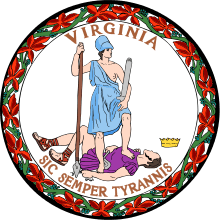George William Smith (politician)
| George William Smith | |
|---|---|
 | |
| 17th Governor of Virginia | |
|
In office April 3, 1811 – December 26, 1811 | |
| Preceded by | James Monroe |
| Succeeded by |
Peyton Randolph (acting) James Barbour |
| Member of the Virginia House of Delegates | |
|
In office 1802-1808 | |
| Personal details | |
| Born |
1762 Essex County, Virginia |
| Died |
December 26, 1811 Richmond, Virginia |
| Political party | Democratic-Republican |
| Spouse(s) | Sarah Adams, Jane Reade Jones |
| Profession | Lawyer |
George William Smith (1762 – December 26, 1811) was a Virginia lawyer and politician, who served several terms in the Virginia House of Delegates and was twice the acting governor of the state before then being elected as the 17th Governor of Virginia. His term as elected governor was short and ended tragically with his death in the Richmond Theatre fire of 1811.
Early life
George William Smith was born in 1762 at the family estate "Bathurst" in Essex County, Virginia, to Alice and Meriwether Smith.[1] His father was a notable Virginia politician, having served in the House of Burgesses, the Continental Congress and the Virginia House of Delegates.[2] George Williams Smith took up the practice of law, and was married twice. His first marriage to Sarah Adams in 1793 produced children, though his second marriage to Jane Reade Jones did not.[3]
Political career
Like his father, the younger Smith soon entered politics, first representing Essex County in the Virginia House of Delegates before taking his law practice to the city of Richmond. He again won election to the Virginia House from 1802 to 1808, this time representing Richmond.[1] He was appointed to the Virginia Council of State Council and soon became its senior member and thus the Lieutenant Governor of Virginia.[2]
As the senior member of the Virginia Council, Smith became as the acting Governor of Virginia, between the terms of John Tyler, Sr. and James Monroe, for five days in January 1811.[4] He became acting Governor again, from April to December of the same year, when Monroe resigned to become United States Secretary of State.[4] Smith was then elected to the office in his own right as the 17th Governor of Virginia, representing the Democratic-Republican Party.[4] However, his official tenure lasted only three weeks before his death during the great Richmond Theatre fire of December 26, 1811.[5] Governor Smith had initially reached safety, but he went back into the fire and died trying to find his young son.[1] The Governor's sudden and unexpected death left the Virginia executive branch in turmoil, prompting acting Governor Peyton Randolph to push the legislature to swiftly appoint a successor.[6]
Smith's ashes were placed under a rock at Monumental Church in Richmond with the ashes of other victims of the fire including former senator and president of the Bank of Virginia, Abraham B. Venable.
References
- 1 2 3 Smith, Margaret Vowell (1893). Virginia, 1492-1892; a brief review of the discovery of the continent of North America, with a history of the executives of the colony and of the commonwealth of Virginia. Washington, W.H. Lowdermilk & Co. p. 318. ISBN 9781176416864. Retrieved 5 August 2015.
- 1 2 "Guide to the Governor George William Smith Executive Papers, 1811-1812". Library of Virginia. Retrieved 6 August 2015.
- ↑ Tyler, Lyon Gardiner (1915). Encyclopedia of Virginia Biography, Vol. 2. Lewis Historical Publishing Company. p. 47. ISBN 1330041925.
- 1 2 3 "Governors of Virginia". Encyclopedia of Virginia. Virginia Foundation for the Humanities. Retrieved 5 August 2015.
- ↑ "Virginia Governor George William Smith". National Governors Association.
- ↑ Baker, Meredith Henne (2012). The Richmond Theater Fire : early America's first great disaster. Baton Rouge: Louisiana State University Press. p. 73. ISBN 9780807143742.
External links
- Archival Records
| Political offices | ||
|---|---|---|
| Preceded by James Monroe |
Governor of Virginia 1811 |
Succeeded by Peyton Randolph Acting Governor |
